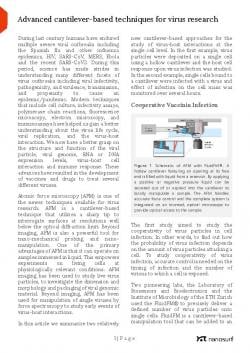Advanced cantilever-based techniques for virus research
During last century humans have endured multiple severe viral outbreaks including the Spanish flu and other influenza epidemics, HIV, SARS-CoV, MERS, Ebola and the recent SARS-CoV2. During this period, science has made strides in understanding many different facets of virus outbreaks including viral infectivity, pathogenicity, and virulence, transmission, and propensity to cause an epidemic/pandemic. Modern techniques that include cell culture, infectivity assays, polymerase chain reactions, fluorescence microscopy, electron microscopy, and immunoassays have helped us gain a better understanding about the virus life cycle, viral replication, and the virus-host interaction. We now have a better grasp on the structure and function of the viral particle, viral genome, RNA or DNA expression levels, virus-host cell interaction and immune response. These advances have resulted in the development of vaccines and drugs to treat several different viruses.
